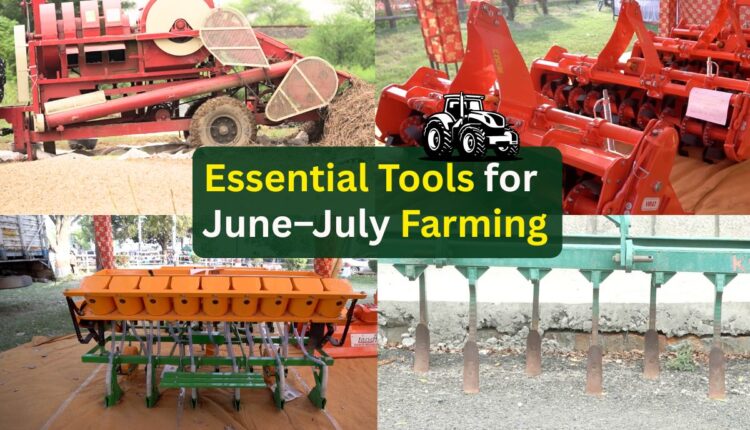Farm Machinery for June: The June–July Kharif season starts with the southwest monsoon and marks the beginning of India’s main cropping cycle. Farmers get ready to plant monsoon crops like paddy (rice), maize, cotton, pulses (e.g., arhar, moong), and millets (jowar, bajra). Timely land preparation and sowing are crucial since the rains offer a short planting window.
In today’s Indian farming, machinery helps get this done quickly despite labour shortages and uncertain weather. India is the world’s largest tractor market, and a good monsoon directly increases farm equipment use as farmers rush to prepare fields. Below is a list of the main machines used during the June–July Kharif season, how they help with crop operations, and their use in different regions.
Tractor
The tractor powers most farm operations in India. In June–July, farmers use it for land preparation—plowing dry or moist soil, puddling rice fields, and pulling tools like harrows, cultivators, and rotavators to ready the seedbed. As soon as rains begin, farmers use tractors with ploughs or disk harrows to turn soil, bury crop remains, and manage weeds. In rice areas, tractors with cage wheels or puddler tools churn flooded fields into soft mud needed for transplanting paddy.
Tractors also move farm inputs and produce. Tractor-trolleys carry seeds, fertilizers, seedlings, and later, harvested crops. In Punjab and Haryana, tractors handle nearly every task in paddy farming—from field prep to grain transport. In central and southern India, smaller or mini-tractors help quickly sow cotton or millets after rain. Where buying a tractor is too costly, farmers hire them through custom hiring centers or cooperatives.
For example, to boost pulse production, the government provided 35 HP tractors with tools in 60,000 villages across key pulse-growing states. This helped small farmers sow pulses on time in Madhya Pradesh, Maharashtra, and Karnataka. Tractors support nearly every Kharif task by making large-scale farming possible within tight timelines.
Rotavator (Rotary Tiller)
A rotavator is a tractor tool with spinning blades that break and mix soil. Farmers use it during the monsoon to create a fine seedbed in one go. After plowing or once rains soften the soil, they run the rotavator to crush clods, mix crop waste, and level the field. This tool works better than a plough alone, especially for small seeds or in rice fields needing a muddy bed.
In rice, farmers often run the rotavator after basic tillage to smooth and soften the field for transplanting. For upland crops like maize, cotton, or millets, it helps mix fertilizers or manure and remove weeds before sowing.
The rotavator handles primary and secondary tillage at once, saving time during the short planting window. Farmers once had to plough, then harrow or cultivate several times—now, one rotavator pass can do it all. Fewer field passes also preserve soil moisture during unpredictable rain. Studies show a tractor rotavator saves 20–30% in energy and fuel versus using a cultivator and disc harrow separately.
It works especially well in light soils, cutting fuel use and speeding crop turnover. Rotavators are popular in high-use areas—Punjab and Western UP farmers use them to mix paddy stubble before the next crop. In peninsular India, governments supply rotavators through custom hiring to help rainfed farms prepare seedbeds quickly. Farmers value rotavators for saving time and improving soil condition, making them a go-to tillage tool for Kharif farming.
Seed Drill / Planter
Seed drills and planters sow seeds (and sometimes fertilizer) in rows at the right depth and spacing. Once fields are ready in June–July, farmers use tractor-drawn drills to quickly and evenly sow Kharif crops. These tools are key for maize, millets, pulses, and cotton, usually sown early in the monsoon. With a seed drill, one farmer can cover acres in a day, a task that would take much longer by hand. The drill covers seeds with soil, improving germination and shielding them from rain or birds.
In maize, farmers use ridger-seed drills that cut furrows, drop seeds (and sometimes fertilizer), and cover them. This ensures even plant spacing and better yields. For pulses or soybean, seed-cum-fertilizer drills sow crops right after the first rain. India has built many region-specific drills and planters for crops like paddy, sorghum, Bengal gram, and groundnut.
Groups like CIAE and state agri universities have designed tools like the tractor-drawn cup-feed drill for paddy, cotton planters, and multi-crop seeders. These tools let farmers place seeds precisely for paddy, coarse grains, pulses, oilseeds, and maize.
During Kharif, quick sowing is vital—any delay after rain cuts yields. Seed drills let farmers plant quickly with little labor and avoid seed waste. Some drills drop fertilizer with seeds to help early growth. Use of drills has grown in both mechanized and rainfed areas. In Madhya Pradesh and Maharashtra, the government offered drills on hire to improve pulse sowing.
In Gujarat and Telangana, cotton farmers use tractor planters for ridged sowing, helping later spraying or weeding. Some areas even use drills for direct rice seeding, skipping transplanting when rains are late. These machines bring speed and accuracy to Kharif sowing across the country.
Paddy Transplanter
A paddy transplanter is a machine that plants rice seedlings into flooded fields, replacing manual planting. Rice is a key Kharif crop, and farmers normally raise seedlings in nurseries, then transplant them by hand during June–July. This takes time and labor. Mechanical transplanters plant several rows at once, cutting both effort and time.
They’re vital in areas with labor shortages. Punjab, a major paddy-growing state, adopted rice transplanters due to rising labor costs and limited farmhands. By 2018, about 150 transplanters planted 4,500 acres in Punjab.
As manual transplanting costs rose (₹3000+ per acre), machines proved cheaper and faster. Transplanters helped farmers finish on time when the rains came. Punjab and other states support them with subsidies and hiring services.
In South India, Tamil Nadu and Andhra Pradesh also use transplanters due to labor gaps. Local centers offer these machines to small farmers. The machine uses a tray to hold mat-type seedlings, which its fingers plant in rows. This ensures even spacing and depth, boosting yields and input use.
It also reduces strain from bending in water. Smaller models suit narrow, terraced fields in hilly areas like the North-East. The transplanter speeds up rice planting and cuts labor needs, especially in major paddy zones facing worker shortages.
Water Pumps
Managing water during the monsoon is key, and water pumps help ensure crops get enough water—or get rid of too much. Farmers use diesel, electric, and now solar pumps. In June–July, these pumps irrigate fields when rains are late or uneven. Though Kharif crops rely on rain, dry spells can hurt young plants. Pumps lift groundwater or canal water to keep soil moist for paddy, cotton, or pulses.
In Punjab and Haryana, tube wells often run before full monsoon arrival to flood rice fields. In central and southern states, cotton or soybean may need irrigation if rains pause in July. With over 30 million irrigation pumps in India, these tools are central to farming. Groundwater pumped by them supports much of the Kharif (and rabi) area, making India the top global user of farm groundwater.
Pumps also help drain flooded fields. In rain-heavy zones like Eastern India or coastal plains, pumps remove extra water to save crops. They also lift water for sprinklers or to mix with fertilizers or sprays. In eastern states like Bihar and West Bengal, small pumps irrigate delayed paddy. In Maharashtra and Karnataka, large community pumps fill canals on schedule. Solar pumps under schemes like PM-KUSUM now bring irrigation to remote farms. Pumps give Kharif farmers a buffer against unpredictable rains, keeping crops watered and yields stable.
Sprayers
Sprayers protect crops during the monsoon. They apply pesticides, fungicides, herbicides, and foliar nutrients. Kharif weather supports pests and disease, so timely spraying is key. For example, rice farmers spray to manage brown planthopper or stem borer. Cotton growers spray for bollworms or sucking pests. Millets and pulses need protection from fungal diseases. Sprayers allow fast, even chemical application—manual dusting can’t match that.
One early-season task is weed control. Weeds shoot up after sowing. Farmers spray herbicides in rows or on rice to check growth before the canopy closes. As pests build, cotton and paddy farmers spray insecticides or fungicides to protect crops. Having sprayers ensures timely control before problems spread.
India offers many sprayer types. Small farmers use hand or battery-operated backpack sprayers. Large farms use motorized or tractor-towed sprayers with long booms. Some areas use high-clearance sprayers for tall crops like cotton or tur. Manufacturers supply power sprayers, mist blowers, and aerial kits to improve reach and speed. Sprayers save time and labor—one person with a sprayer can replace a team of manual workers.
In Maharashtra’s cotton zones, battery sprayers are common due to pest load. In rice belts, cooperatives rent out boom sprayers for quick, large-area spraying during disease outbreaks. Sprayers help keep crops healthy and yields high during the monsoon.
Cultivator
A cultivator has multiple tines and is either tractor-mounted or run by animals or power tillers. It’s used to loosen soil and remove weeds. In Kharif, cultivators help with two main tasks: pre-sowing land prep and inter-row weeding. Before sowing, farmers run a cultivator to break topsoil, mix old stubble, and kill early weeds. This loosens the soil and improves air and water flow for seeds. It’s often used instead of deep plowing, especially when rains have softened the ground.
Once crops grow, cultivators (or smaller intercultivators) weed between crop rows. In row crops like cotton, maize, or pigeon pea, farmers pass a cultivator between rows a few weeks after sprouting. It removes weeds and breaks soil crust formed by rain. This improves soil condition and helps retain moisture. Cultivators offer a low-cost way to improve soil and reduce weed pressure.
Contact us – If farmers want to share any valuable information or experiences related to farming, they can connect with us via phone or whatsapp at 9599273766 or you can write to us at “[email protected]”. Through Kisan of India, we will convey your message to the people, because we believe that if the farmers are advanced then the country is happy.
You can connect with Kisan of India on Facebook, Twitter, and Whatsapp and Subscribe to our YouTube channel.



